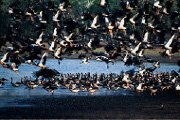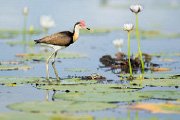History
Kakadu has been home to Aboriginal people for more than 65,000 years and our Culture is strong.
Now that Kakadu is a national park, we work with Parks Australia to welcome people to our Country and keep it healthy.
Our changing lifestyle
Our Aboriginal ancestors were hunter-gatherers. As the seasons changed, they moved around the park to find food and comfort.
There were no permanent settlements, but we would use favourite camping areas for many, many generations. Our ancestors used temporary dwellings such as stringy-bark and paperbark shelters near billabongs, wet-season huts built on stilts on the floodplains, and rock shelters in the Stone Country.
When non-Aboriginal people arrived in the Kakadu area, our Aboriginal population decreased markedly. Many people died of disease or moved off their land to towns and settlements.
The reduced population and the introduction of vehicles and shops have changed our traditional seasonal movements. We are able to base ourselves in an outstation or town and use vehicles to shop, to visit different outstations, to attend ceremonies and to move about the Country on hunting trips.
About 2,000 people lived in the Kakadu area before the arrival of non-Aboriginal people. Now there are about 500 Aboriginal people living in 18 outstations dotted throughout the park.
The beginning of the park
Kakadu National Park was declared in stages, starting in the 1970s.
It was a time when Australians were becoming more interested in declaring national parks for conservation and in recognising the land interests of Aboriginal people. The name Kakadu was suggested to recognise Gagudju, an Aboriginal language which used to be spoken in the park.
A new stretch of woodland, called Koongarra (Kunkarra), was recently added to Kakadu National Park. Koongarra (Kunkarra)’s key Traditional Owner, Jeffrey Lee, fought for more than a decade to prevent mining in his ancestral lands. In 2013, he saw his dream realised when Koongarra (Kunkarra) became part of Kakadu, protecting it forever.
Koongarra (Kunkarra) lies in the shadow of Burrungkuy (Nourlangie) rock – if you pause at the lookout to marvel at the view, you are looking at Koongarra (Kunkarra). On its other side, Koongarra (Kunkarra) faces Lightning Dreaming, home of Namarrkon or Lightning Man, the creation ancestor responsible for the dramatic electrical storms on the Arnhem plateau.
Take the first step
A journey of 1000 miles begins with a single click.
Enter your email to get free trip planning advice from Kakadu rangers.





